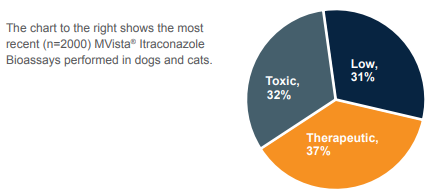Itraconazole Therapeutic Drug Monitoring – Is it Necessary?
At a Glance – Crucial Information
- Itraconazole is an effective and commonly used antifungal drug
- Adverse effects (AEs) are reported in 8-33% of dogs and cats treated [1Legendre AM, Rohrbach BW, Toal RL, et al. Treatment of blastomycosis with itraconazole in 112 dogs. J Vet Intern Med 1996;10:365-371., 2Mancianti F, Pedonese F, Zullino C. Efficacy of oral administration of itraconazole to cats with dermatophytosis caused by Microsporum canis. J Am Vet Med Assoc 1998;213:993-995., 3Elanco. Itrafungol Package Insert. In. Greenfield, IN: Elanco; 2019.]
- AEs are more common with higher itraconazole blood levels
- Treatment failure is more likely with sub-therapeutic blood levels
- Blood levels are highly variable (both too high and low) even with appropriate dosing [4Renschler J, Albers A, Sinclair-Mackling H, et al. Comparison of Compounded, Generic, and Innovator-Formulated Itraconazole in Dogs and Cats. J Am Anim Hosp Assoc 2018;54:195-200.]
- Therapeutic drug monitoring (TDM) of blood levels is recommended
- TDM should be done after steady-state- 2 weeks in dogs and 3 weeks in cats
- MVista® Itraconazole Bioassay is a cost-efficient option for TDM
- MVista® Itraconazole Bioassay accounts for itraconazole and all active metabolites
Case Example
Carter is a 4-year-old, castrated, male small breed dog. He was receiving generic itraconazole solution (Patriot Pharmaceuticals) at a typical dose (6 mg/kg/day) for blastomycosis. Routine monitoring of liver enzymes revealed increased ALT activity (500 U/L, RI=12-118), increased AST activity (75 U/L, RI=15-66), and increased ALP activity (306 U/L, RI=5-131). Itraconazole blood levels, measured by MVista® Itraconazole Bioassay, were above the recommended therapeutic range (16.0 µg/mL, RI=2-7). Due to evidence of hepatoxicity due to elevated itraconazole blood levels the itraconazole dose was decreased to 4 mg/kg/day. Itraconazole blood levels by MVista® Bioassay, 3 weeks later, were significantly closer to the recommended therapeutic range (8.2 µg/mL, RI=2-7). Repeat serum biochemistry at that time revealed that ALT (48 U/L, RI=12-118) and ALP (100 UL, 5-131) had normalized.
Discussion
Itraconazole is a commonly used antifungal drug in veterinary medicine. It is effective against common fungal pathogens including Blastomyces, Coccidioides, Cryptococcus, and Histoplasma. Adverse effects (AE) include anorexia, vomiting, diarrhea, hepatotoxicity and skin lesions [1Legendre AM, Rohrbach BW, Toal RL, et al. Treatment of blastomycosis with itraconazole in 112 dogs. J Vet Intern Med 1996;10:365-371.]. These AEs are more likely with excessively high itraconazole blood levels [1Legendre AM, Rohrbach BW, Toal RL, et al. Treatment of blastomycosis with itraconazole in 112 dogs. J Vet Intern Med 1996;10:365-371., 2Mancianti F, Pedonese F, Zullino C. Efficacy of oral administration of itraconazole to cats with dermatophytosis caused by Microsporum canis. J Am Vet Med Assoc 1998;213:993-995., 3Elanco. Itrafungol Package Insert. In. Greenfield, IN: Elanco; 2019.]. As Carter’s case demonstrates itraconazole blood levels are highly variable and are commonly outside of the recommended therapeutic range, even with appropriate doses (Table and Chart below). Low levels are at least as common as toxic levels and can lead to treatment failure. Collectively this suggests that the starting dose of itraconazole for any dog or cat is, at best, an educated guess. When considering the wide variability in age, sex, breed, comorbidities, concurrent medications and other treatments, and drug formulations – it’s amazing we ever guess correctly. Therapeutic drug monitoring (itraconazole blood levels) is required to guide individualized patient care and minimize the risks of AEs and treatment failure.
Itraconazole blood levels can be measured by different methods and the MVista® Bioassay uses the inhibition of fungal growth for this purpose. Two advantages of the Bioassay are cost-savings and the fact that it accounts for itraconazole and all active metabolites. One disadvantage is that the administration of other antifungal drugs can lead to falsely high results. Blood concentrations should be checked, after reaching steady-state, when starting itraconazole or changing the dose. Steady-state is achieved in 2 weeks in dogs and 3 weeks in cats. Trough blood levels (immediately before next dose) are ideal, but due to the long half-life, levels can be checked anytime during the day.
The table below shows the key findings of a population-based study demonstrating many dogs and cats treated with appropriate doses of itraconazole have low or potentially toxic blood levels [4Renschler J, Albers A, Sinclair-Mackling H, et al. Comparison of Compounded, Generic, and Innovator-Formulated Itraconazole in Dogs and Cats. J Am Anim Hosp Assoc 2018;54:195-200.].
Therapeutic2.0 – 7.004 (10%)10 (30%)Toxic> 7.0027 (68%)16 (49%)
| Category | Concentration (µg/mL) | Compounded (n=42) | Generic FDA (n=40) | Sporanox® (n=33) |
|---|---|---|---|---|
| Low | < 2.0 | 42 (100%) | 9 (22%) | 7 (21%) |
The chart to the right shows the most recent (n=2000) MVista® Itraconazole Bioassays performed in dogs and cats. 
REFERENCES:
- Legendre AM, Rohrbach BW, Toal RL, et al. Treatment of blastomycosis with itraconazole in 112 dogs. J Vet Intern Med 1996;10:365-371.
- Mancianti F, Pedonese F, Zullino C. Efficacy of oral administration of itraconazole to cats with dermatophytosis caused by Microsporum canis. J Am Vet Med Assoc 1998;213:993-995.
- Elanco. Itrafungol Package Insert. In. Greenfield, IN: Elanco; 2019.
- Renschler J, Albers A, Sinclair-Mackling H, et al. Comparison of Compounded, Generic, and Innovator-Formulated Itraconazole in Dogs and Cats. J Am Anim Hosp Assoc 2018;54:195-200.

